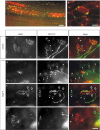The neurite outgrowth inhibitor Nogo-A promotes denervation in an amyotrophic lateral sclerosis model
- PMID: 17039253
- PMCID: PMC1679784
- DOI: 10.1038/sj.embor.7400826
The neurite outgrowth inhibitor Nogo-A promotes denervation in an amyotrophic lateral sclerosis model
Abstract
Amyotrophic lateral sclerosis (ALS) is a neurodegenerative disease characterized by motor neuron loss and muscle wasting. In muscles of ALS patients, Nogo-A-a protein known to inhibit axon regeneration-is ectopically expressed at levels that correlate with the severity of the clinical symptoms. We now show that the genetic ablation of Nogo-A extends survival and reduces muscle denervation in a mouse model of ALS. In turn, overexpression of Nogo-A in wild-type muscle fibres leads to shrinkage of the postsynapse and retraction of the presynaptic motor ending. This suggests that the expression of Nogo-A occurring early in ALS skeletal muscle could cause repulsion and destabilization of the motor nerve terminals, and subsequent dying back of the axons and motor neurons.
Figures


References
-
- Azzouz M, Ralph GS, Storkebaum E, Walmsley LE, Mitrophanous KA, Kingsman SM, Carmeliet P, Mazarakis ND (2004) VEGF delivery with retrogradely transported lentivector prolongs survival in a mouse ALS model. Nature 429: 413–417 - PubMed
-
- Bezakova G, Ruegg MA (2003) New insights into the roles of agrin. Nat Rev Mol Cell Biol 4: 295–308 - PubMed
-
- Bruijn LI, Miller TM, Cleveland DW (2004) Unraveling the mechanisms involved in motor neuron degeneration in ALS. Annu Rev Neurosci 27: 723–749 - PubMed
-
- Caroni P, Schwab ME (1988) Antibody against myelin-associated inhibitor of neurite growth neutralizes nonpermissive substrate properties of CNS white matter. Neuron 1: 85–96 - PubMed
-
- Clement AM et al. (2003) Wild-type nonneuronal cells extend survival of SOD1 mutant motor neurons in ALS mice. Science 302: 113–117 - PubMed
Publication types
MeSH terms
Substances
LinkOut - more resources
Full Text Sources
Other Literature Sources
Medical
Molecular Biology Databases
Miscellaneous

